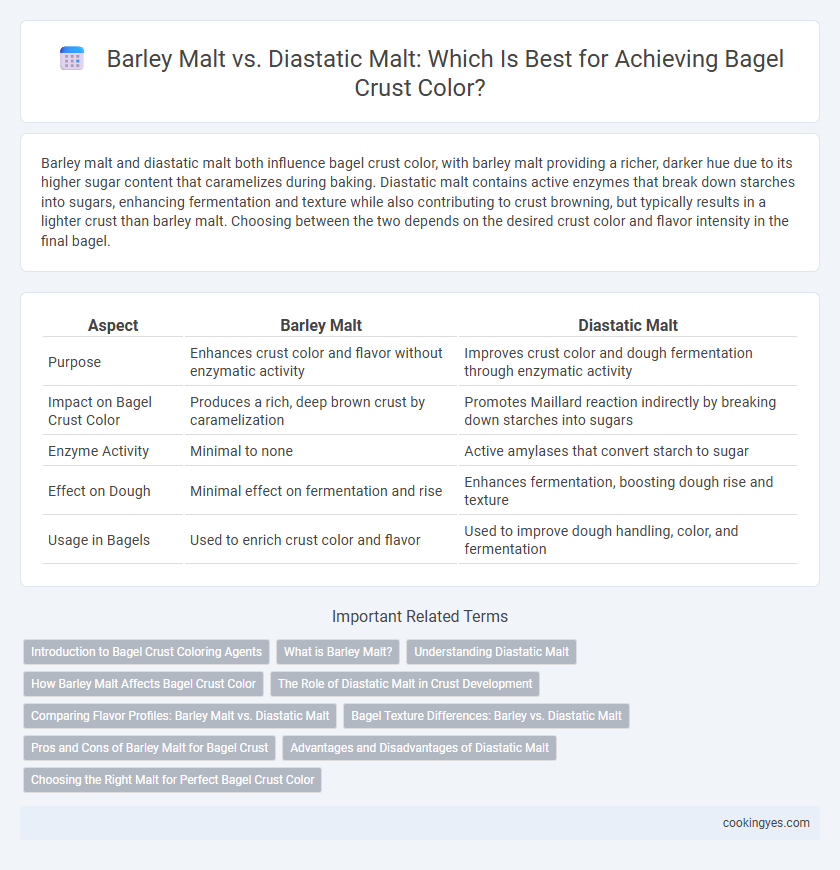Barley malt and diastatic malt both influence bagel crust color, with barley malt providing a richer, darker hue due to its higher sugar content that caramelizes during baking. Diastatic malt contains active enzymes that break down starches into sugars, enhancing fermentation and texture while also contributing to crust browning, but typically results in a lighter crust than barley malt. Choosing between the two depends on the desired crust color and flavor intensity in the final bagel.
Table of Comparison
| Aspect | Barley Malt | Diastatic Malt |
|---|---|---|
| Purpose | Enhances crust color and flavor without enzymatic activity | Improves crust color and dough fermentation through enzymatic activity |
| Impact on Bagel Crust Color | Produces a rich, deep brown crust by caramelization | Promotes Maillard reaction indirectly by breaking down starches into sugars |
| Enzyme Activity | Minimal to none | Active amylases that convert starch to sugar |
| Effect on Dough | Minimal effect on fermentation and rise | Enhances fermentation, boosting dough rise and texture |
| Usage in Bagels | Used to enrich crust color and flavor | Used to improve dough handling, color, and fermentation |
Introduction to Bagel Crust Coloring Agents
Barley malt and diastatic malt both play crucial roles in developing the characteristic golden-brown crust of bagels, but their functions differ significantly. Barley malt syrup, rich in sugars, promotes Maillard browning and imparts a slightly sweet, caramelized flavor that enhances crust color and texture. Diastatic malt contains active enzymes that break down starches into fermentable sugars, aiding yeast activity and crust browning, but excessive use can affect dough consistency and flavor balance.
What is Barley Malt?
Barley malt is a natural sweetener derived from malted barley that enhances the crust color of bagels through the Maillard reaction during baking, promoting a rich, golden-brown appearance. Unlike diastatic malt, which contains active enzymes to break down starches and improve dough fermentation, barley malt primarily contributes to flavor and browning without significantly affecting dough structure. Its use in bagel recipes results in a slightly sweet, robust crust color while maintaining the traditional chewy texture characteristic of authentic bagels.
Understanding Diastatic Malt
Diastatic malt contains active enzymes that break down starches into fermentable sugars, enhancing yeast activity and improving bagel dough fermentation. This enzymatic action contributes to a deeper, richer crust color by promoting Maillard browning during baking. In contrast, barley malt primarily adds color through its natural sugars but lacks the enzymatic power to influence fermentation and crust development as effectively as diastatic malt.
How Barley Malt Affects Bagel Crust Color
Barley malt plays a crucial role in enhancing bagel crust color by promoting Maillard reactions during baking, resulting in a rich, golden-brown appearance. Its natural sugars caramelize on the surface, intensifying the crust's hue and contributing subtle sweetness. Unlike diastatic malt, barley malt lacks active enzymes, focusing solely on color and flavor development without impacting dough fermentation.
The Role of Diastatic Malt in Crust Development
Diastatic malt contains active enzymes that break down starches into fermentable sugars, enhancing yeast activity and contributing to a deeper, more even crust color on bagels. This enzymatic action promotes Maillard reactions during baking, resulting in a rich, golden-brown crust compared to barley malt, which primarily adds sweetness without enzymatic benefits. Using diastatic malt in bagel dough improves both crust texture and color intensity by optimizing sugar availability for caramelization and browning.
Comparing Flavor Profiles: Barley Malt vs. Diastatic Malt
Barley malt imparts a rich, slightly sweet flavor with caramel undertones, enhancing the traditional bagel crust's depth and color through natural sugars. Diastatic malt contributes less sweetness but promotes enzymatic activity, improving fermentation and dough strength without significantly altering flavor. Choosing barley malt intensifies the crust's taste and color, while diastatic malt is preferred for texture and rise optimization.
Bagel Texture Differences: Barley vs. Diastatic Malt
Barley malt enhances bagel crust color by caramelizing sugars during baking, resulting in a deep golden-brown hue and a slightly sweet flavor. Diastatic malt improves bagel texture by breaking down starches into fermentable sugars, promoting better yeast activity and producing a chewier, more elastic crumb. The combination of barley malt and diastatic malt balances crust color and authentic bagel chewiness, optimizing both appearance and texture.
Pros and Cons of Barley Malt for Bagel Crust
Barley malt enhances bagel crust color by providing a rich, deep brown hue and a subtle sweetness, which improves the overall flavor profile. It contains enzymes that are less active than diastatic malt, reducing the risk of over-fermentation but may result in slower dough rise. However, barley malt lacks the strong enzymatic activity needed for optimal gluten development, potentially affecting the bagel's texture compared to diastatic malt.
Advantages and Disadvantages of Diastatic Malt
Diastatic malt enhances bagel crust color by promoting enzymatic activity that breaks down starches into sugars, resulting in better Maillard browning and a richer, darker crust. Its advantage lies in improving dough fermentation and texture through these enzymes, but excessive use can cause over-fermentation, leading to a gummy crumb and overly dark crust. Unlike barley malt, which mainly adds sweetness and color, diastatic malt offers functional benefits in dough conditioning, making it ideal for achieving the desired bagel crust appearance and texture when properly balanced.
Choosing the Right Malt for Perfect Bagel Crust Color
Choosing the right malt is crucial for achieving the perfect bagel crust color, with barley malt providing a rich, deep amber hue due to its high sugar content that caramelizes during baking. Diastatic malt, containing active enzymes, contributes to crust color by breaking down starches into sugars, promoting even browning and a slightly lighter, golden crust. Understanding the distinct roles of barley malt and diastatic malt allows bakers to tailor crust appearance and flavor to their desired bagel outcome.
Barley malt vs diastatic malt for bagel crust color Infographic

 cookingyes.com
cookingyes.com